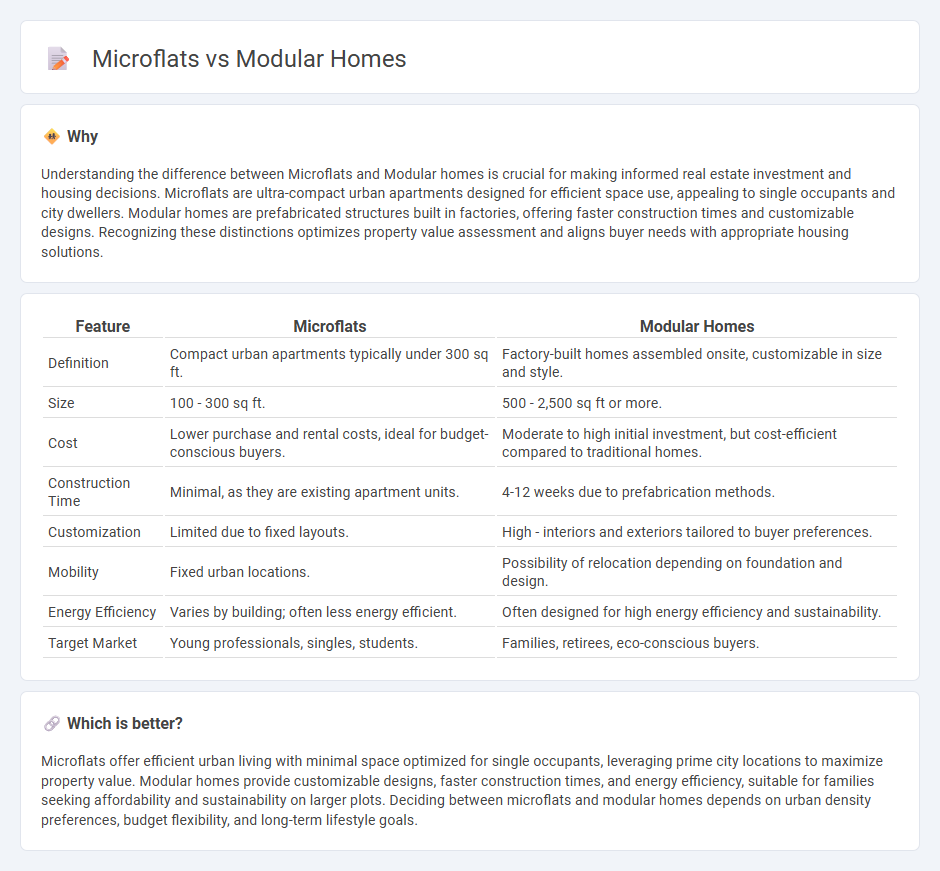
Microflats offer compact, affordable urban living spaces designed for efficiency and minimalism, while modular homes provide customizable, factory-built residences assembled quickly on-site, often with superior energy efficiency. Both real estate solutions address housing shortages by maximizing space utilization and reducing construction time. Explore the advantages and trade-offs of microflats versus modular homes to find the best option for your needs.
Why it is important
Understanding the difference between Microflats and Modular homes is crucial for making informed real estate investment and housing decisions. Microflats are ultra-compact urban apartments designed for efficient space use, appealing to single occupants and city dwellers. Modular homes are prefabricated structures built in factories, offering faster construction times and customizable designs. Recognizing these distinctions optimizes property value assessment and aligns buyer needs with appropriate housing solutions.
Comparison Table
| Feature | Microflats | Modular Homes |
|---|---|---|
| Definition | Compact urban apartments typically under 300 sq ft. | Factory-built homes assembled onsite, customizable in size and style. |
| Size | 100 - 300 sq ft. | 500 - 2,500 sq ft or more. |
| Cost | Lower purchase and rental costs, ideal for budget-conscious buyers. | Moderate to high initial investment, but cost-efficient compared to traditional homes. |
| Construction Time | Minimal, as they are existing apartment units. | 4-12 weeks due to prefabrication methods. |
| Customization | Limited due to fixed layouts. | High - interiors and exteriors tailored to buyer preferences. |
| Mobility | Fixed urban locations. | Possibility of relocation depending on foundation and design. |
| Energy Efficiency | Varies by building; often less energy efficient. | Often designed for high energy efficiency and sustainability. |
| Target Market | Young professionals, singles, students. | Families, retirees, eco-conscious buyers. |
Which is better?
Microflats offer efficient urban living with minimal space optimized for single occupants, leveraging prime city locations to maximize property value. Modular homes provide customizable designs, faster construction times, and energy efficiency, suitable for families seeking affordability and sustainability on larger plots. Deciding between microflats and modular homes depends on urban density preferences, budget flexibility, and long-term lifestyle goals.
Connection
Microflats and modular homes share a connection through their emphasis on efficient space utilization and affordability in real estate. Both housing types leverage innovative design and prefabrication techniques to reduce construction costs and accelerate development timelines. This synergy addresses growing urban housing demands by providing compact, cost-effective living solutions.
Key Terms
Prefabrication
Modular homes utilize large prefabricated sections manufactured in controlled factory environments, ensuring high precision, faster construction timelines, and consistent quality compared to traditional builds. Microflats often incorporate prefabricated components like bathroom pods or kitchen units to optimize space efficiency and minimize onsite assembly time, though they typically rely on conventional building methods for structural elements. Explore the advancements in prefabrication techniques to understand how these housing options address modern urban living challenges.
Space Efficiency
Modular homes utilize prefabricated sections to maximize available square footage, offering customizable layouts that can adapt to varying space requirements. Microflats emphasize minimalism by condensing living essentials into compact, multifunctional areas often under 300 square feet, optimizing vertical storage and transformable furniture. Explore detailed comparisons to determine which housing solution best suits your space efficiency needs.
Zoning Regulations
Zoning regulations significantly impact the development of modular homes and microflats, dictating where these structures can be built and their permissible sizes. Modular homes often face fewer restrictions in suburban and rural zones but encounter challenges in urban areas with strict building codes, while microflats are designed to maximize space within dense urban zoning limits. Explore detailed zoning requirements and compliance strategies to better understand which housing solution fits your project goals.
Source and External Links
Modular Homes - Champion Homes - Offers modular homes with innovative designs, energy efficiency, and affordability, adhering to local building codes.
Modular Home Floorplans | Next Modular - Provides customizable modular home floor plans and a turn-key experience for a hassle-free home building process.
Modular Homes & Prefab Additions by Westchester Modular Homes - Specializes in custom modular homes with a focus on speed and quality, offering a range of styles from Craftsman to Colonials.
 dowidth.com
dowidth.com